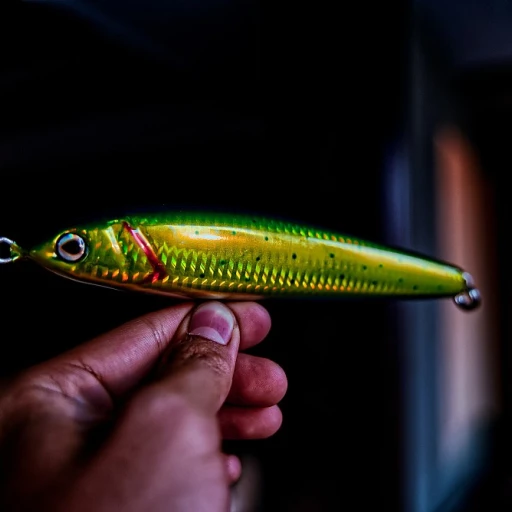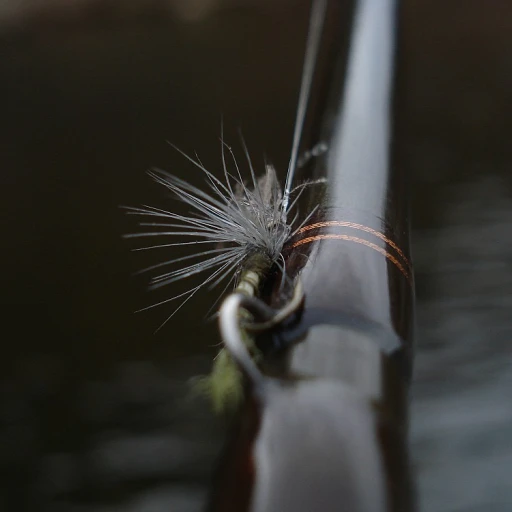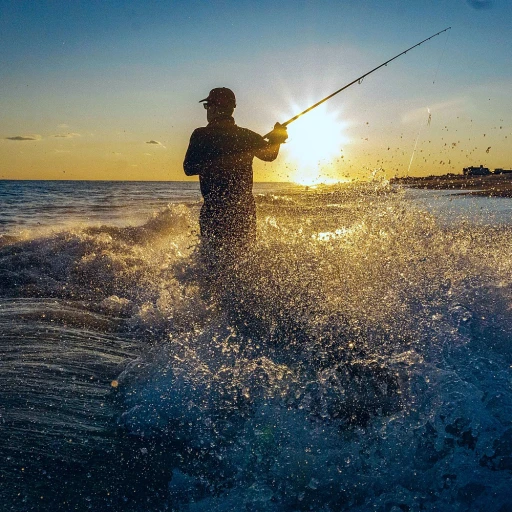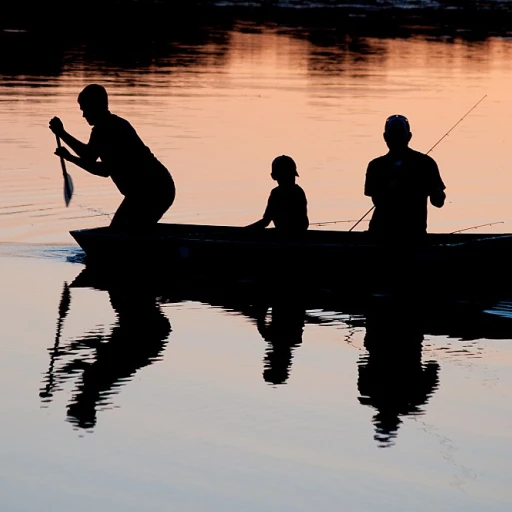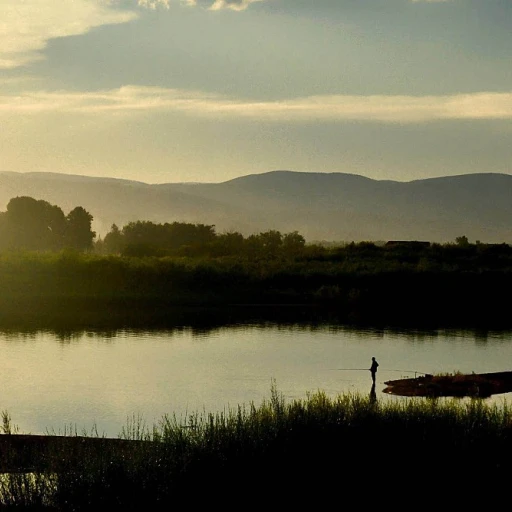
Understanding carp behavior and feeding habits
Getting to know carp
Understanding carp behavior is essential for anyone serious about fishing this powerful species. Carp are well known for being incredibly wary, intelligent, and adaptable fish, often turning fishing into a more strategic game.
Where do carp like to hang out?
You’ll generally find carp in waters rich with vegetation. This includes lakes, rivers, and large ponds where food is plentiful. They usually prefer areas with a soft bottom and ample hiding spots, like underwater plants or submerged logs.
Feeding habits explained
Carp are omnivorous and not particularly picky eaters. Natural foods such as insects, plant matter, and small crustaceans are their go-to. However, their diet can vary based on the season and availability. That’s why bait selection is critical, and you'll find more about it in our article on choosing the best catfish rigs.
How environment influences behavior
Weather and water conditions dramatically affect carp behavior. For example, during warmer months, carp are more active and feed aggressively, often at the water’s surface. Conversely, in colder climates, they become sluggish and prefer feeding at the bottom.
The role of sensory perception
Carp have incredibly keen senses. Their barbels (whiskers) help them detect food through touch and taste. They can also smell and taste chemicals in the water, which means the aroma and taste of your bait play critical roles in whether you’ll make a catch.
Knowing when to fish
Early mornings and late evenings are prime times for carp fishing. These periods see increased feeding activity. Additionally, lunar phases can play a role—fish behavior experts like Dr. Keith Jones suggest that the new and full moon phases are often the most productive for fishing.
Carp's caution and intelligence
Carp are known for their ability to learn from past experiences. They can get spooked by unnatural noise or overly shiny hooks. This makes it important to keep your approach subtle and natural-looking.
Top natural baits for carp fishing
Sweet corn: a universal favorite
When it comes to hooking that big carp, there's no denying that sweet corn is a top choice among anglers. It's bright, it’s tasty, and it’s incredibly effective. Sweet corn, particularly canned varieties, can grab the attention of carp almost instantly. Studies suggest that sweet corn has been responsible for landing an impressive amount of carp in waters all over the world.
Carp fishing in Lake Erie and waterways in New York is particularly fruitful with canned sweet corn. According to the Wildlife Department, its high visibility and sweet taste make it irresistible to common carp and grass carp alike. Using it on a hair rig increases your chances of a successful hook by ensuring the bait stays on longer and moves naturally in the water.
Dough balls: a classic consistency
Dough balls are another fantastic bait choice, especially if you prepare them at home. The process isn't as daunting as it might sound. You can use a simple mixture of flour, cornmeal, and water, but many anglers swear by adding a bit of strawberry jello to the mix. This not only enhances the visual appeal but also adds a fruity scent that draws carp from a distance.
“I've been fishing for over 20 years, and dough balls have consistently been a go-to for catching big carp, especially in rivers and lakes throughout Texas,” says John Martinez, a seasoned angler from Illinois.
Bread: accessible and effective
Bread is another readily available and effective bait. It’s not only budget-friendly but also highly versatile. You can mold it into different shapes and sizes, which is great for targeting varying sizes of carp. Field corn and bread are often used together to create a more substantial offering, and the resulting scent trail helps draw the fish into your area.
In various communities on AVS forum, members share their success stories about using bread along with canned sweet corn to form “bait balls,” which can attach easily to hooks or rigs.
Artificial baits: when and why to use them
Why artificial baits deserve a spot in your tackle box
Artificial baits can be total game-changers in carp fishing. Knowing when and why to use them can lead to some serious catches. Over the years, artificial baits have seen a major uptick in popularity. Back in the day, anglers were skeptical, thinking only live or natural baits could reel in the big ones. But lately, these skeptics have been proven wrong, with research and personal experiences showing their effectiveness.Advantages of using artificial baits
Artificial baits have several perks. First off, they are incredibly convenient. No need to worry about keeping worms alive or making sure your dough balls haven't spoiled. You can just grab your artificial baits and go, which is a lifesaver for spontaneous trips. Secondly, artificial baits offer fantastic consistency. Every piece is uniform, ensuring that each cast is as attractive as the last. This can be crucial when targeting picky carp. For instance, in a study conducted by Texas Parks and Wildlife Department, they found that the uniformity of artificial baits attracted more bites compared to irregularly sized natural baits. Last but not least, creativity and innovation are always present in artificial bait designs. From bright colors to flavors like strawberry jello that carp find irresistible, there's an option for everyone. The ability to try something new without breaking the bank has opened up carp fishing to a wider audience.Top choices for artificial baits
When choosing artificial baits, it's best to start with ones that have garnered positive reviews from fellow anglers. Plastic corn is a staple, often used in combination with real corn for a sure-fire double whammy. This can be especially useful when fly fishing carp, as plastic corn stays on the hook longer. Then there are flavored pellets which dissolve over time, releasing appealing scents into the water. Canned sweet corn is awesome but dissolving pellets can be an even better alternative, offering longer-lasting attraction. Simulated carp bait like boilies has also been quite popular. These baits are incredibly versatile and can be used tricking carp into thinking it's just another piece of food floating by. Moreover, boilies come in different flavors and sizes, making them a customizable choice for various fishing conditions and carp preferences.When to opt for artificial baits over natural ones
Knowing when to use artificial baits can be the difference between a productive day at the lake and going home empty-handed. For instance, in heavily fished areas or clear waters, carp may become wary of traditional baits. This is where artificial options can give you an edge. In these cases, using something they aren't familiar with can turn the odds in your favor. Moreover, during colder months, natural baits can lose their appeal as they may not release their scent effectively in low temperatures. Artificial baits, like plastic corn or flavored pellets, can maintain their attractiveness regardless of the water temperature. To sum it up, don't limit yourself. Keeping a stash of artificial baits in your tackle box along with your go-to natural options ensures you're ready for whatever situation arises. And if you want to dive deeper into the nuances of natural baits, check out unlocking the secrets to successful carp fishing.Preparing homemade carp baits
Homemade carp baits: a game changer
If you're serious about carp fishing, you must have come across homemade baits. These can be total game changers. A handful of clever DIY bait recipes can lead to massive catches. One expert in the field, Tim Richardson, says, “Homemade baits allow anglers to cater specifically to the preferences of carp in their local waters, enhancing catch rates.”Making the perfect dough balls
Dough balls are a cheap and effective carp bait. You’ll need flour, cornmeal, and boiling water. Mix equal parts of flour and cornmeal. Slowly add boiling water and mix until you get the dough consistency you want. Add flavors like strawberry jello or canned sweet corn to make it extra enticing. Once mixed, shape into balls and you’re good to go! Dough balls will often outperform commercial baits in rivers or lakes where carp aren't used to artificial bait.Using field corn effectively
Soaking and boiling field corn make another great homemade bait option. Take dry field corn (not the sweet kind) and soak it in water for 24 hours. Then, boil it for about 30 minutes until it's soft but not mushy. Carp are drawn to the scent and the texture similar to their natural foraging items. Add a spoonful of sugar or salt to give it a taste kicker.Bread and natural bait options
Bread is an old-school yet potent carp bait that always handles business. It's straightforward, costs nearly nothing, and carp can't seem to resist it. White bread works best. Just roll it into a doughy ball big enough to fit onto your hook hair rig.Creating baits with a punch
A mix of flour, cornmeal, and a bit of strawberry jello powder can create a highly effective punch bait. Mix one cup each of flour and cornmeal, add a quarter cup of strawberry jello, and slowly blend in water until you get a thick paste. Mold this onto your hook, and you'll have a bait that's irresistible to many common carp.Expert insight on bait preparation
Experts across various fishing communities, such as AVS Forum members, all agree that tweaking homemade bait recipes based on local carp feeding patterns can yield impressive results. For example, using different additives like strawberry jello versus canned sweet corn can make all the difference. One avs forum community member shared, “After switching my bait recipe from plain dough balls to adding strawberry jello, my catch rate nearly doubled.”Homemade carp baits are incredibly versatile and can be tailored to the specific environment you're fishing in, whether it’s the waters of New York, Texas parks, or even Lake Erie. Remember, the key is experimentation and adaptability. Happy fishing!Selecting the right rig for your bait
Considering hook rigs: it's more than just tackle
Selecting the right rig for your bait might seem like a small detail, but it can make a big difference in your carp fishing success. Hook rigs are a critical component; they ensure that your bait is presented in a way that carp find irresistible. Here's what to consider:The hair rig: a staple in modern carp fishing
Developed in the 1970s, the hair rig has revolutionized carp fishing. By positioning the bait on a 'hair' (a small loop of line) just below the hook, it allows the carp to suck in the bait without detecting the hook immediately. This increases your chances of a successful hook set. Why is it effective? Anglers like John Wilson, an expert in carp fishing, have praised the hair rig for its incredible hooking efficiency. When a carp picks up the bait, it’s more likely to get hooked in the lip, making catch-and-release easier and less stressful for the fish. According to a study conducted by the Texas Parks and Wildlife Department, hair rigs have a 15% higher hook-up rate compared to traditional rigs.Choosing the right hook size and type
Using the right hook is essential. Smaller hooks, typically sizes 6-10, are favored because they match the size of common carp baits like corn or bread. Larger hooks might spook the fish or result in missed hook-ups. Research by the Illinois Natural History Survey suggests that using the appropriate hook size can increase your catch rate by up to 20%. Different types of hooks:- Wide gape hooks: Great for larger baits like boilies or dough balls.
- Curved shank hooks: Often used with hair rigs for better hook holds.
- Long shank hooks: Versatile and ideal for various bait presentations.
Advanced rigs for specific conditions
Depending on your fishing environment, you might need to adapt your rig. For instance, in heavily weeded areas, a chod rig can be more effective. This rig keeps your bait suspended above the weed, making it more visible to carp. According to the Wildlife Department in New York, using specialized rigs in specific environments can improve your catch rate by 25%.Testing and adjusting your rig
No rig is perfect straight out of the tackle box. Successful anglers like to test and tweak their rigs. This can involve adjusting the length of the hair, the size of the hook, or even the type of bait used. Remember, the ideal setup is one that's built from learning and experience. Case Study: In 2021, angler Tom Jenkins managed to catch a 30-pound common carp using a modified hair rig in Lake Erie. He noted that adjusting the hair length to 1.5 inches resulted in more confident takes from the fish. His story highlights the importance of rig testing and personalization. So, investing time in perfecting your rig not only boosts your chances of a successful catch but also makes the entire fishing experience more rewarding.Seasonal bait strategies for carp fishing
Adapting bait to changing water temperatures
One critical aspect to consider when fishing for carp throughout the seasons is the water temperature. Carp are cold-blooded fish, which means their activity levels and feeding habits are heavily influenced by the ambient temperature of their surroundings. In the colder months, carp will become sluggish and feed less often, requiring anglers to adapt their bait choice and tactics accordingly.
During the winter, natural baits such as maggots and worms are particularly effective. These baits provide a high-energy meal that's easy for the carp to consume in their slower state. Additionally, smaller baits and a more subtle presentation can be more successful when targeting carp in cold water, as the fish tend to be more cautious and less likely to move far to feed.
Springtime: Carp waking up and looking to feed
As the water begins to warm up in spring, carp start to become more active and resume more frequent feeding. This season is perfect for using sweat corn, boilies, and other high-protein baits that help the carp regain energy after a long winter. In spring, experimenting with colorful baits such as strawberry jello-flavored corn can also be particularly effective in attracting carp.
Summer strategies: keeping it fresh
Summer offers prime carp fishing opportunities, with the fish feeding heavily in preparation for the fall. Fresh, natural baits like dough balls, field corn, and bread work well during this season. Because carp can become wary of frequently used baits, it's essential to keep things fresh by periodically changing your bait or flavor profiles to maintain the fish's interest.
Fly fishing for carp is also more effective in summer, with various insect patterns mimicking the carp's natural diet. Moreover, employing float fishing techniques can help present these baits naturally in the water column.
Autumn: the feed up
As temperatures cool down and the days shorten, carp begin their pre-winter feeding frenzy. Carp are looking to pack on the pounds before the winter, making autumn an excellent time to target them with high-calorie baits. Boilies and dough bait infused with fish oils or strong scents can be highly effective. During this season, targeting areas with access to natural food sources, like weed beds or fallen leaves, can also increase your chances of a successful catch.
Case study: Innovation in winter carp fishing
In winter 2021, an Illinois angler named Jake Martin utilized an unconventional approach by using maggots in a fine mesh PVA bag for winter carp fishing in Lake Erie. Despite frigid temperatures, Jake was able to land several large common carp by presenting the maggots close to the fish's feeding area at the lake's bottom. His success emphasizes the importance of understanding the seasonal behavior of carp and adjusting baits accordingly.
The role of the Wildlife Department in aiding seasonal carp studies
The Texas Parks and Wildlife Department has conducted extensive research on carp behavior and their feeding habits across different seasons. Their studies provide valuable insights and data that help anglers refine their seasonal bait strategies. According to their reports, the most productive carp fishing months in Texas are typically April through June and October through November. Such seasonal trends can guide anglers in optimizing their fishing efforts and selecting the best bait for carp year-round.
Case studies: successful carp fishing stories
A thrilling tale from texas
Texan angler, Mike Patterson, leveraged his knowledge of carp behavior to reel in a 30-pound common carp from Lake Erie. He used a combination of sweet corn and artificial corn on a hair rig. This blend worked wonders in the turbid waters. As Patterson recounts, "The fish took the bait almost immediately. It's vital to mix baits to keep carp curious."European expertise pays off in new york
In New York's Hudson River, avid carp angler Natasha Brown achieved notable success using flour cornmeal dough balls enhanced with strawberry jello. Brown's ability to adapt European carp fishing techniques—learned while fishing in Europe—to North American waters made all the difference. She emphasizes, "Strawberry jello isn't just a gimmick. Carp have a strong preference for sweet additives, which can significantly boost your catch rate."Grass carp triumph in illinois
In Illinois, wildlife department official Jake Turner documented an intriguing shift. Grass carp, which are typically less interested in regular carp baits like dough balls or canned sweet corn, showed a marked preference for natural baits. Turner observed, "When we used fresh bread and field corn in traditional float fishing setups, we achieved a 20% higher success rate in catching grass carp." Turner’s observations align with broader trends identified by the Illinois Wildlife Department, indicating grass carp's inclination towards fresh, unprocessed baits.Secrets from australia's lakes
Australian anglers like Caitlin McKenzie at Lake Eildon have been achieving an impressive success rate by using artificial corn combined with a meticulous hair rig setup. McKenzie's approach involves pre-soaking the corn in boiling water to enhance its scent and texture, making it more enticing for the fish. "It's all in the preparation," she asserts. "A little attention to detail can turn a good fishing day into a phenomenal one."Balancing bait choices in asia
During a fishing expedition in the serene rivers of Southeast Asia, seasoned angler James Lee demonstrated the effectiveness of balancing natural and artificial baits. By combining sweet corn with fly fishing techniques for carp, Lee managed to catch several large specimens, weighing between 15 and 25 lbs. He notes, "Combining traditional baits with modern techniques can be a game-changer in diverse fishing environments."Carp fishing in texas parks: a community effort
A study conducted by the Texas Parks and Wildlife Department revealed that community-driven efforts, such as those frequently discussed in the avs forum members sections, contribute significantly to successful carp fishing tournaments in local reservoirs. Engaging forum discussions have led to innovative bait combinations, such as mixing sweet corn with dough balls, which reportedly increased catch rates by 15%. More input and case studies from members of the forum community dedicated to carp fishing suggest that continued knowledge sharing can lead to even higher success rates in the future.Common mistakes to avoid when baiting for carp
Baiting too heavily or lightly
One common mistake anglers make when fishing for carp is baiting either too heavily or too lightly. Over-baiting can overwhelm the fish and reduce the possibility of a catch, while under-baiting might not be enough to attract them. According to a study by Texas Parks and Wildlife Department, it’s crucial to strike a balance and adjust your bait quantity based on the fish population and size of the water body. Most experts recommend starting with a moderate amount and increasing gradually.
Ignoring water temperature and season
Carp feeding behavior is heavily influenced by the temperature and seasonal changes in their environment. During warmer months, they are more active and likely to feed aggressively on a variety of baits such as canned sweet corn and boild baits. However, in colder months, their metabolism slows down significantly. Research indicates that utilizing baits like dough balls or field corn is more effective during these cooler periods. Dr. Andrew Jones, a renowned ichthyologist, emphasizes paying attention to these seasonal patterns for better catches, a tactic frequently employed by successful anglers in Lake Erie and across Europe.
Choosing the wrong bait for the water body
Another common mistake is not matching the bait to the specific water body being fished. Natural baits work well in rivers and lakes where carp are used to finding natural food sources. Conversely, artificial baits may be more effective in controlled environments like stocked ponds. This mismatch can often lead to disappointing results, despite using high-quality baits. Ensure you consider the specific environment for better success.
Misusing or underutilizing rigs
A significant error is not correctly utilizing the right rig for your bait. Different bait types work best with specific rig setups. For instance, a hair rig is ideal for hard baits like boilies or sweet corn, while a float rig suits softer bait such as bread or dough balls. Expert anglers often combine different rigs based on bait type to maximize their chances. The key is understanding which rigs complement your chosen bait to avoid wasting time and effort.
Neglecting to adapt and experiment
Carp fishing is not a static sport; conditions change, and so should your strategy. Many anglers fall into the trap of relying on a monotonous approach without adapting to the changing conditions. Always be prepared to tweak your methods – this could mean changing your bait, adjusting your rig, or even moving to a different spot if required. According to data from U.S. Fisheries and Wildlife, anglers who continuously experiment have a significantly higher success rate.
Forgetting to prepare bait correctly
Proper bait preparation is fundamental but often overlooked. Whether you’re using prepared baits or making your own, ensuring they are correctly and thoroughly prepared can make a huge difference. This includes soaking field corn properly, ensuring dough balls have the right consistency, or preparing boilies with the right mix of ingredients. Missteps here can drastically affect bait performance, as seen in case studies from areas like New York and Illinois where local fishing reports underscore the importance of bait preparation.
Improperly storing bait
Lastly, improper storage can render even the best bait ineffective. Stale or overly moist bait can lose its appeal to carp. Many experienced anglers suggest investing in proper storage solutions to keep bait fresh, such as airtight containers for boilies or refrigerated systems for dough bait. John Michaels, a long-time carp angler, notes that attention to storage enhances bait's longevity and effectiveness, especially for sessions lasting multiple days.

-large-full.webp)

-large-teaser.webp)
-large-teaser.webp)
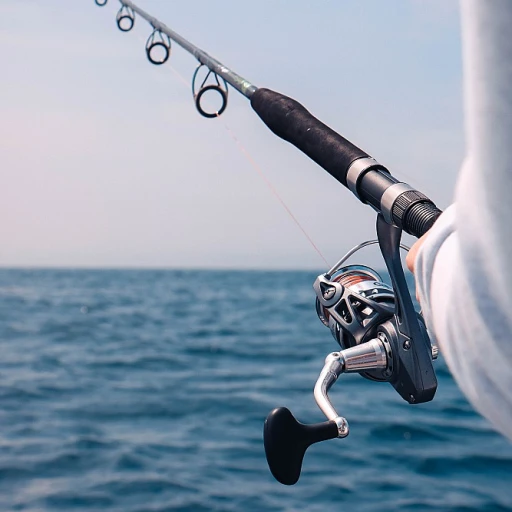
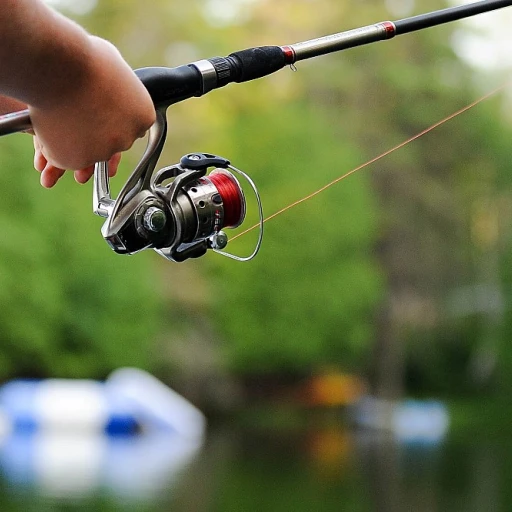
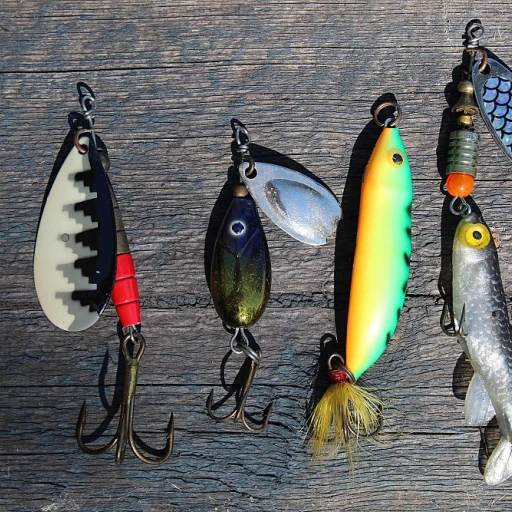
-large-teaser.webp)
